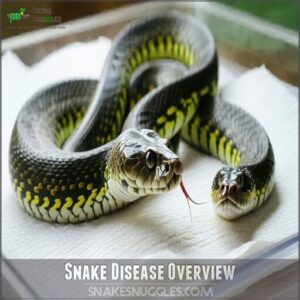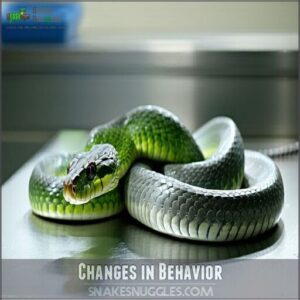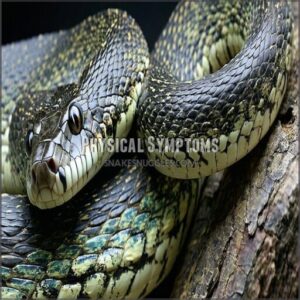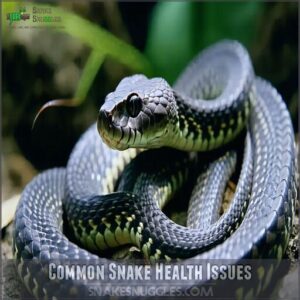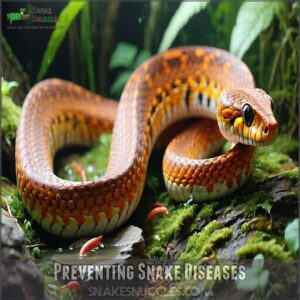This site is supported by our readers. We may earn a commission, at no cost to you, if you purchase through links.
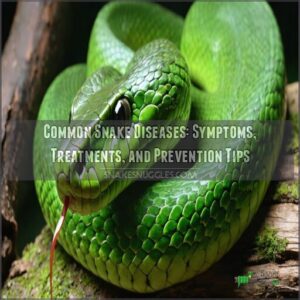
Infectious stomatitis (mouth rot) presents as redness and discharge around the mouth, while scale rot causes discoloration and lesions on the belly scales.
Respiratory infections manifest through wheezing, bubbling at the nostrils, and open-mouth breathing.
Inclusion body disease (IBD) is particularly serious for boas and pythons, causing neurological symptoms.
Parasites, both internal and external, can also plague your slithery companion.
Maintaining proper temperature, humidity, and cleanliness in your snake’s enclosure is your first line of defense against these troublesome conditions.
Table Of Contents
- Key Takeaways
- Snake Disease Overview
- Signs of Snake Diseases
- Treating Snake Diseases
- Common Snake Health Issues
- Preventing Snake Diseases
- Frequently Asked Questions (FAQs)
- What does an unhealthy snake look like?
- What is the most common disease in reptiles?
- What diseases does a pet snake have?
- What skin diseases can be transmitted by animals?
- What is snake fungal disease?
- Can a snake get sick?
- What diseases can snakes give you?
- What is the most common cause of death in snakes?
- How do you know if a snake is infected?
- How do environmental factors affect snake health?
- Conclusion
Key Takeaways
- Keep your snake’s enclosure clean, maintain proper temperature and humidity, and check for signs of infections or parasites regularly.
- Watch for symptoms like wheezing, swollen mouth, lethargy, discolored skin, or appetite changes, and act fast to prevent potential health issues.
- Provide a balanced diet with appropriate prey size, fresh water, and avoid overfeeding to prevent obesity and nutritional deficiencies.
- Schedule regular vet check-ups to catch potential health issues early and ensure your snake stays healthy and thriving.
Snake Disease Overview
Regarding your snake’s health, understanding common diseases is essential for keeping them happy and thriving.
From mouth infections to respiratory issues, recognizing the symptoms early can make all the difference in their recovery.
Infectious Stomatitis
Infectious stomatitis, or snake mouth rot, often stems from poor hygiene, injuries, or stress.
Stomatitis symptoms include swollen gums, thick mucus, and a sour smell. Left untreated, this bacterial infection worsens.
Treatment protocols involve cleaning the mouth, antibiotic options, and addressing the cause. Prevention measures like maintaining clean enclosures and proper care help avoid this common snake bacterial infection known as mouth rot.
For effective treatments, research snake mouth rot solutions.
Skin Infections
Snake skin infections, like dermatitis, scale rot, and fungal diseases, arise from poor hygiene or excessive moisture.
Addressing these issues requires quick action and good habits:
- Clean cages and swap moist bedding regularly.
- Watch for red, blistered, or crusty skin.
- Apply antibiotics or antifungals as directed.
- Seek a vet for severe infections.
Maintain dryness to prevent snake bacterial skin infections. Environmental factors can also lead to ulcerative dermatitis, which may cause ulcerative conditions, and it is crucial to address these issues promptly to prevent severe infections.
Respiratory Disease
Struggling to breathe? Respiratory disease in snakes often stems from bacterial pneumonia, fungal infections, or environmental factors like poor humidity.
Respiratory diseases in snakes are preventable with proper humidity, cleanliness, and quick action at the first signs of distress.
Symptoms include wheezing, lethargy, and nasal discharge.
Treatment options range from antibiotics to nebulization.
| Cause | Symptom | Diagnosis | Prevention |
|---|---|---|---|
| Bacterial Pneumonia | Nasal discharge | X-rays | Ideal temperatures |
| Fungal Infections | Wheezing | Cultures | Sanitary enclosures |
| Parasites | Lethargy | Blood tests | Quarantine newcomers |
| Poor Housing | Loss of appetite | Endoscopy | Regular vet check-ups |
The table outlines the causes, symptoms, diagnosis, and prevention methods for respiratory diseases in snakes, highlighting the importance of ideal temperatures and sanitary enclosures in preventing these conditions.
Septicemia
Respiratory issues aren’t the only bacterial threat—septicemia, a severe bloodstream infection, can quickly turn fatal.
Poor husbandry, injuries, or parasite infestations often cause snake septicemia. Symptoms include red belly scales, lethargy, and weak tongue movement.
Septicemia diagnosis requires veterinary care, with antibiotics, fluids, and warmth as critical treatments. Prevention hinges on spotless enclosures, quarantine, and parasite control.
Signs of Snake Diseases
When your snake isn’t acting quite like itself, it could be a sign of illness you shouldn’t ignore.
Watch for changes in appetite, unusual behavior, or visible physical symptoms, as these can help you spot problems early and keep your slithery friend healthy.
Changes in Appetite
Anorexia in snakes isn’t just a missed meal—it’s often a sign of deeper issues.
Watch for:
- Refusal to eat, which could signal stress or snake diseases.
- Weight loss with lethargy, hinting at dietary deficiencies.
- Obesity risks from overfeeding attempts.
Seek help if force-feeding snakes becomes necessary, as appetite loss might mask life-threatening snake disease symptoms requiring urgent care.
Changes in Behavior
Behavioral changes, like sudden lethargy or aggression, can signal snake diseases.
Hiding excessively or showing regurgitation and unusual shedding patterns may also indicate stress or illness.
Observing your pet is vital to spotting these red flags.
Use this quick guide to recognize common behavioral shifts.
| Behavior | Possible Cause |
|---|---|
| Lethargy | Infection or disease |
| Aggression | Pain or discomfort |
| Excess Hiding | Stress or sickness |
| Regurgitation | Improper diet |
| Unusual Shedding | Poor environment setup |
This guide helps you identify potential issues, such as infection or disease, by monitoring your pet’s behavior and environment.
Physical Symptoms
Watch for snake symptoms like skin abnormalities, scale discoloration, or unusual lumps—these could hint at infections or snake skin conditions.
Other red flags include breathing difficulties, mouth swelling, and lethargy. Loss of appetite might seem minor but often signals underlying issues.
If your snake struggles with respiratory infections or persistent skin problems, a vet visit could save its life. Be aware that unusual resting positions can also indicate illness.
Treating Snake Diseases
Treating snake diseases requires patience and precise care to address infections, injuries, and other health issues effectively.
You’ll need to use antibiotics, antifungals, and supportive therapies while ensuring proper isolation to prevent spreading illnesses.
Antibiotics and Antifungals
Snake antibiotic treatment targets bacterial infections like mouth rot, focusing on proper dosage calculation and administration methods (oral or injectable).
Prevent antibiotic resistance by completing prescribed treatments.
Snake antifungal treatment, essential for fungal infections, includes topical or systemic antifungal options, and understanding environmental factors is key to prevention.
Always monitor side effects like lethargy or appetite loss, and consult your vet for customized antibiotics and antifungal treatment plans.
Supportive Care
When treating snake diseases, supportive care is your cornerstone for recovery.
Focus on essentials like fluid therapy to prevent dehydration, pain relief to ease discomfort, and nutritional support for weakened snakes.
Wound management and proper temperature regulation are vital, ensuring your snake’s environment mirrors its natural habitat.
Always consult a vet for customized care strategies.
Consider purchasing fluids online for convenience.
- Fluid therapy prevents dehydration.
- Pain relief promotes comfort.
- Nutritional support keeps energy up.
- Temperature regulation aids recovery.
Quarantine and Isolation
Isolating an infected snake is essential for preventing disease spread.
Set up a quarantine area in a separate room with dedicated tools and supplies. New snake arrivals should undergo a 30-90 day observation period before joining your collection.
During quarantine, monitor for signs of illness while maintaining strict biosecurity measures. This isolation setup helps contain contagious diseases like IBD or respiratory infections, protecting your healthy specimens from potentially devastating outbreaks, which is crucial for preventing the spread of disease and ensuring the health of your collection, including the prevention of respiratory infections.
Common Snake Health Issues
You’ll need to monitor your snake for common health issues including infectious stomatitis, parasitic infections, skin diseases, and respiratory problems.
Early recognition of symptoms such as mouth inflammation, weight loss, abnormal shedding, or labored breathing will help guarantee prompt treatment and prevent serious complications, ensuring early recognition is crucial for your snake’s health.
Parasites and Infections
Parasites pose significant health risks to captive snakes.
External parasites like mites and ticks can cause anemia and transmit tick-borne diseases, while internal parasites often require deworming medications for effective treatment.
Fecal analysis during annual check-ups helps detect intestinal parasites before they cause serious harm.
Cryptosporidiosis impact can be devastating, causing digestive issues and weight loss.
Snake bacterial infections often accompany parasitic problems, creating a complex treatment scenario that requires veterinary expertise.
Viral Diseases
While parasites present visible threats, viral diseases in captive snakes often work silently but devastatingly.
Viral diseases can be difficult to diagnose and nearly impossible to cure.
Four viral threats that keep reptile veterinarians up at night:
- Inclusion Body Disease – affects the nervous system with tremors and regurgitation
- Paramyxovirus – causes respiratory distress and secondary infections
- Nidovirus (Serpentovirus) – particularly deadly in pythons
- Ferlavirus – common in vipers, with high mortality rates
Nutritional Disorders
Three common nutritional disorders affect captive snakes: calcium imbalances, vitamin deficiencies, and obesity.
Without proper calcium, snakes develop metabolic bone disease, causing weakened skeletons and deformities.
Vitamin deficiencies, particularly A and D3, lead to poor shedding and immune function.
Overfeeding creates obesity risks, especially in sedentary species.
Proper prey gutloading enhances nutrition quality.
Snakes can also suffer from thiamine deficiencies if fed incorrectly prepared fish.
Regular snake veterinary care can identify these issues before they become severe, making good snake husbandry essential.
Preventing Snake Diseases
You’ll prevent most common snake diseases by maintaining proper hygiene, correct temperature gradients, and appropriate humidity levels in your snake’s enclosure.
Regular veterinary check-ups, proper nutrition, and careful quarantine procedures for new snakes will further safeguard your reptile’s health and longevity.
Proper Housing and Hygiene
After addressing parasites and infections, let’s focus on your snake’s living environment – a key factor in disease prevention.
Proper housing and hygiene directly impact your pet’s health and longevity. Good snake husbandry starts with appropriate enclosure setups.
Selecting the right substrate is also essential; you can buy snake substrate online.
- Select substrate choices that balance cleanliness with natural behavior
- Maintain a temperature gradient allowing proper thermoregulation
- Follow consistent cleaning protocols to eliminate waste and bacteria
- Implement humidity control systems appropriate for your specific species
Diet and Nutrition
Proper nutrition stands as the cornerstone of disease prevention in captive snakes.
You’ll need to match prey size to your snake’s girth and maintain appropriate feeding frequency based on species and age.
Nutritional deficiencies often lead to metabolic bone disease and immune suppression, so consider vitamin supplementation when recommended.
Make certain constant access to fresh water, as hydration importance can’t be overstated for preventing kidney issues and supporting proper digestion.
Regular Veterinary Check-Ups
While good nutrition forms the foundation of snake health, regular check-ups with an exotic veterinarian are equally important.
Schedule annual exams for your snake to facilitate early detection of potential issues.
These visits typically include parasite screening, weight monitoring, and a husbandry review. A reptile specialist can spot subtle health changes before they become serious problems—something even experienced keepers might miss.
Preventative care is always less stressful than treating established snake diseases, and it allows for the early detection of potential health issues, making it a crucial part of snake health, alongside regular annual exams.
Frequently Asked Questions (FAQs)
What does an unhealthy snake look like?
Like a wilting flower, your unhealthy snake might show cloudy eyes, irregular breathing, weight loss, discolored skin patches.
Open-mouth breathing, mucus around nostrils, swollen mouth, lethargy, abnormal shedding, or red belly scales are also possible signs of an unhealthy snake.
What is the most common disease in reptiles?
Parasitic infections are the most common disease you’ll encounter in reptiles.
You’ll typically find both internal parasites (helminths, protozoa) and external ones (mites, ticks) that can cause weight loss and anemia if left untreated.
What diseases does a pet snake have?
Contrary to popular belief, pet snakes can develop several health issues.
Your snake might experience infectious stomatitis (mouth rot), respiratory infections, parasitic infestations, skin infections, or anorexia.
Regular vet checkups help catch these problems early, which is a critical step in maintaining the snake’s health.
What skin diseases can be transmitted by animals?
Animals can transmit skin conditions like ringworm, mange, or scabies.
These infections are caused by fungi, mites, or parasites.
Always wash your hands after handling animals and guarantee their hygiene to prevent transmission.
What is snake fungal disease?
Snake fungal disease, a nightmare for snake enthusiasts, is caused by Ophidiomyces ophiodiicola.
It damages the skin, causing lesions, crusting, or blisters.
Prompt veterinary care and an impeccably clean habitat can help prevent its spread.
Can a snake get sick?
Absolutely, snakes can get sick from infections, parasites, or environmental issues.
Watch for signs like lethargy, appetite loss, or odd behaviors.
Regular vet checkups and proper care help keep your slithery friend healthy.
What diseases can snakes give you?
Snakes can carry Salmonella, which may transfer to you through handling or contaminated surfaces.
Proper handwashing after contact is key.
Rarely, parasites like ticks might spread diseases if ignored, so regular cleaning helps.
What is the most common cause of death in snakes?
Think of snakes as little adventurers, but even they face challenges.
The most common death cause is septicemia, a severe blood infection often from injuries or untreated illnesses.
Prompt care and hygiene are lifesaving essentials!
How do you know if a snake is infected?
Watch for signs like drooling, open-mouth breathing, lethargy, nasal discharge, or swelling.
Unusual behaviors, color changes, or appetite loss can also hint at infection.
If symptoms persist, a vet visit guarantees proper diagnosis and treatment.
How do environmental factors affect snake health?
Your snake’s health depends on its environment.
Poor hygiene, extreme humidity, or incorrect temperatures can cause infections or stress.
Think of it as their sanctuary—keep it clean, cozy, and balanced to guarantee well-being.
Conclusion
An ounce of prevention is worth a pound of cure, especially in regards to common snake diseases.
By keeping your snake’s enclosure clean, properly heated, and humidified, you’ll reduce the risk of infections and parasites.
Watch for signs like wheezing, mouth redness, or appetite changes, and act quickly if they arise.
Providing a balanced diet and regular veterinary check-ups makes certain your pet thrives.
A healthy snake is a happy one—keep that slithery companion in top shape!

